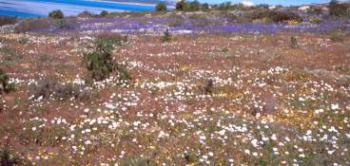Felicia elongata
Felicia elongata (Thunb.) O. Hoffm.
Family: Asteraceae
Common names: Saldanha felicia, tricolour felicia (Eng.), driekleurblommetjie (Afr.)
Introduction
Felicia elongata is a striking perennial daisy, with large white or mauve flowers. What makes this Felicia so different from the other felicias, is the distinctive reddish ring on the petals around the yellow centre of the flower.

Description
Description
The beautiful flowers are formed at the tip of long, thin stems during spring, from late August to September, sometimes until October, depending on the rain. Each plant can easily have from 5 to 15 flowering stems standing about 30 cm tall. Each flower measures about 5 cm across when fully open. The petals unfold to show open faces eager for insects, such as bees, to visit and exchange small amounts of nectar for pollen. Within a month the flowers turn into fluffy seed heads. The flat, oval shaped seeds are dark brown with long bristly hairs attached to the rounded tip.

Conservation Status
Status
Vulnerable. This species has a small population, estimated to be less than 2000 mature individuals and at least 62% of its habitat has been degraded and destroyed by coastal and urban expansion, industrial and agricultural development, limestone mining and overgrazing. The loss of its habitat is ongoing and its wild population is decreasing.
Distribution and habitat
Distribution description
This daisy is quite special to see in the wild, growing naturally only on the limestone hills along the west coast of South Africa, which is known for its beautiful and unique flora, especially in spring when fields of flowers give spectacular displays.
Flowering in August and September the white Felicia elongata is found from the Postberg reserve on the south-eastern side of the Langebaan lagoon towards Saldanha and Paternoster.

So far plants with mauve flowers have only been found near Club Mykonos on the north-eastern side of the lagoon. Sadly because of the beauty of the lagoon, large areas are being developed for housing and recreation. A limestone hill thick with the mauve Felicia elongata has recently been subdivided into small plots, not leaving much space for the survival of the mauve Felicia elongata in its natural habitat.
Annuals such as the brilliant white Cape daisy, Dimorphotheca pluvialis and tall, wavy spikes of blue flax, Heliophila coronopifolia, cover the ground in richly coloured carpets. When one looks more closely, there are hundreds of other different species of annuals, bulbs, succulents, orchids and perennials such as Felicia elongata to be found.
Derivation of name and historical aspects
History
In the genus Felicia (astertjie) there are 83 species found from southern and tropical Africa to Arabia, with 78 species in southern Africa alone.
Ecology
Ecology
The growth pattern of Felicia elongata follows the seasons along the west coast. During the wet winter and spring, Felicia elongata forms thick clumps with bright green foliage. Where exposed they are compact and low but when protected under larger shrubs like Pelargonium fulgidum (rooi malva) and Pelargonium gibbosum (dikbeen malva) they are looser and taller as they stretch towards the light. The long, thin leaves are mostly at the bottom of the stems. The leaves and stems are covered in little white hairs, a feature that helps one to recognize the plants when they are not in flower.
During the long dry summers, rain is scarce with occasional mist the only relief from the heat and the dry, sandy soils. Spotting Felicia elongata in the summer is difficult as they hide under larger bushes and survive as dry sticks, which only shoot again with the onset of the cooler weather and rain in the autumn. Many plants survive the dry summer safely as seeds.
Growing Felicia elongata
Grow
Felicia elongata has been in and out of cultivation for many years. Fortunately it is not that difficult to propagate and is quite easy as a garden plant. They are perennials, but are best grown as annuals for spring display. Although found only on limestone in the wild, they adapt very well to any good garden soil that drains well. They grow best in full sun but will tolerate light shade for part of the day. In very cold areas they need a warm protected spot for they are tender to frost and are not tolerant of prolonged low temperatures.
Felicia elongata can be propagated from seed or cuttings, but seedlings are usually more vigorous. Sow the seed in autumn, or late summer to give the seedlings more time to develop into larger more bushy and therefore more floriferous plants by the spring. Prick the seedlings into small pots and grow on until well established before planting out. Cuttings taken in autumn from new shoots root quite easily.
In the genus Felicia (astertjie) there are 83 species found from southern and tropical Africa to Arabia, with 78 species in southern Africa alone.
References
- Helme, N.A., Raimondo, D., van der Colff, D. & von Staden, L. 2015. Felicia elongata (Thunb.) O.Hoffm. National Assessment: Red List of South African Plants version 2015.1. Accessed on 2016/07/26
Credits
Liesl van der Walt
Kirstenbosch National Botanical Garden
August 2001
Conservation status updated July 2016)
Plant Attributes:
Plant Type: Bi/Annual, Perennial
SA Distribution: Western Cape
Soil type: Sandy, Clay, Loam
Flowering season: Spring
PH: Acid, Alkaline, Neutral
Flower colour: Red, White, Yellow, Mauve/Lilac
Aspect: Full Sun, Afternoon Sun (Semi Shade)
Gardening skill: Easy
Special Features:
Horticultural zones











Rate this article
Article well written and informative
Rate this plant
Is this an interesting plant?
Login to add your Comment
Back to topNot registered yet? Click here to register.